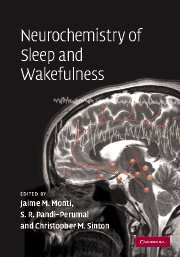Book contents
- Frontmatter
- Contents
- List of contributors
- Preface
- Acknowledgements
- Abbreviations
- I The neurochemistry of the states of sleep and wakefulness
- II The influence of neurotransmitters on sleep and wakefulness
- 4 Gamma-aminobutyric acid and the regulation of paradoxical, or rapid eye movement, sleep
- 5 Acetylcholine modulates sleep and wakefulness: a synaptic perspective
- 6 Histamine in the control of sleep–wakefulness
- 7 Dopamine in behavioral state control
- 8 Glutamate neurotransmission and sleep
- 9 Serotonin and sleep–wake regulation
- III Changing perspectives
- Index
- Plate section
9 - Serotonin and sleep–wake regulation
from II - The influence of neurotransmitters on sleep and wakefulness
Published online by Cambridge University Press: 23 October 2009
- Frontmatter
- Contents
- List of contributors
- Preface
- Acknowledgements
- Abbreviations
- I The neurochemistry of the states of sleep and wakefulness
- II The influence of neurotransmitters on sleep and wakefulness
- 4 Gamma-aminobutyric acid and the regulation of paradoxical, or rapid eye movement, sleep
- 5 Acetylcholine modulates sleep and wakefulness: a synaptic perspective
- 6 Histamine in the control of sleep–wakefulness
- 7 Dopamine in behavioral state control
- 8 Glutamate neurotransmission and sleep
- 9 Serotonin and sleep–wake regulation
- III Changing perspectives
- Index
- Plate section
Summary
Although many questions remain about the complicated role of serotonin and its receptors in regulating sleep and waking, recent neurochemical, electrophysiological, and neuropharmacological studies have revealed much detailed information about this process.
Neural structures and neurotransmitters involved in the regulation of sleep and waking in laboratory animals
The neural structures involved in the promotion of the waking (W) state are located in the (1) brainstem [dorsal raphe nucleus (DRN), median raphe nucleus (MRN), locus coeruleus (LC), laterodorsal and pedunculopontine tegmental nuclei (LDT/PPT), and medial-pontine reticular formation (mPRF)]; (2) hypothalamus [tuberomammillary nucleus (TMN) and lateral hypothalamus (LH)]; (3) basal forebrain (BFB) (medial septal area, nucleus basalis of Meynert); and (4) midbrain ventral tegmental area (VTA) and substantia nigra pars compacta (SNc) (Pace-Schott & Hobson, 2002; Jones, 2003). The following neurotransmitters function to promote W: (1) acetylcholine (ACh: LDT/PPT, BFB); (2) noradrenaline (NA: LC); (3) serotonin (5-HT: DRN, MRN); (4) histamine (HA: TMN); (5) glutamate (GLU: mPRF, BFB, thalamus); (6) orexin (OX: LH); and (7) dopamine (DA: VTA, SNc) (Zoltoski et al., 1999; Monti, 2004).
The neural structures involved in the regulation of W give rise to mainly ascending projections. In this respect (1) NA-, 5-HT-, and HA-containing neurons send long ascending projections to the forebrain and cerebral cortex; (2) DA-containing cells project into the basal ganglia and the frontal cortex; (3) cholinergic neurons from the midbrain tegmentum project to the thalamus (ventromedial, intralaminar, and midline nuclei) and the BFB, and cholinergic BFB neurons have widespread rostral projections to the cerebral cortex and the hippocampus; (4) orexin-containing neurons from the LH project to the entire forebrain and brainstem arousal systems; and (5) glutamatergic neurons make up the projection neurons of the mPRF and thalamus (Baghdoyan & Lydic, 2002; Jones, 2003).
- Type
- Chapter
- Information
- Neurochemistry of Sleep and Wakefulness , pp. 244 - 280Publisher: Cambridge University PressPrint publication year: 2008
- 2
- Cited by



